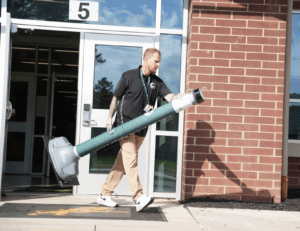Types of Gun Detection Systems
The need for effective gun detection systems in schools has never been more urgent. Since the Columbine Massacre in 1999, gun production in the U.S. has surged by 317%, leading to a dramatic increase in the number of firearms in households across the country. Among these, compact and subcompact handguns are more accessible than ever—often stored in nightstands, backpacks, and purses, where children can easily find them.
As a result, more young children—as young as 3 years old in some cases—are unintentionally bringing firearms to school. Unlike older students who may carry for protection, status, or illicit activities, many of these children simply stumble upon a gun at home and unknowingly bring it into the classroom.
This evolving challenge requires schools to think beyond just violence prevention and consider comprehensive security solutions that address both intentional and unintentional firearm possession. In this blog, we’ll explore different gun detection technologies, their role in school security, and how schools can proactively protect students and staff.
What are Gun Detection Systems?
A gun detection system is any technology designed to identify or prevent firearms from entering a secured area. Some systems focus on detecting the sound of gunfire, while others work to identify concealed weapons before they become a threat. The effectiveness of each system depends on factors such as accuracy, speed, ease of use, and integration with existing security measures.
Key Features of an Effective Gun Detection System
When evaluating gun detection technologies, schools should consider the following factors:
- Accuracy in Threat Detection – Systems should differentiate between real threats and non-threatening metal objects to minimize unnecessary alarms.
- Speed and Efficiency—School environments require the ability to screen large crowds quickly while still detecting potential threats.
- Integration Capabilities—Systems that integrate video surveillance, access control, and security personnel workflows enhance overall safety.
- Real-Time Alerts – Immediate notifications to security teams help ensure swift responses to potential threats.
Types of Gun Detection Technologies on the Market
Today, two types of systems market themselves as “Gun Detection” technology solutions and solely focus on gun detection: Audio – Gunshot Detection and Visual Gun Detection leveraging video surveillance analytics.
However, “weapons detectors” can detect guns and other metallic threats, like knives and pipe bombs, and these systems can include advanced walk-through metal detectors and X-ray machines. For this post, we will only focus on the following:
- Audio Gunshot Detection
- Visual Gunshot Detection
- Walk-Through Weapons Detectors
1. Traditional Walk-Through Metal Detectors
How They Work:
Walk-Through metal detectors use electromagnetic fields to detect the presence of metal objects nearby. They can be set to find the presence of any amount of metal, which is essential for high-security environments like federal and Supermax prisons.
The first walk-through metal detectors were developed and patented by the CEIA S.p.A in Italy in 1979 for high-security checkpoints securing government officials and dignitaries worldwide.
Since then, walk-through metal detectors have also been used to secure nuclear facilities, airports, stadiums, theme parks and event venues, court houses and schools.
As more types of facilities needed metal detection, the need to “discriminate” (differentiate) between metallic threats versus non-threatening personal items that are metal, like coins, keys, belt buckles and mobile phones grew.
Pros:
- Ability to detect small metallic threats
- Best in environments where security is tantamount and speed to screen is not a concern for security screening staff
- Zone Alarming is typically used to isolate and indicate where the potential threat is on the person’s body
- Staff is typically well-trained to mitigate and account for all alarms
- X-Ray equipment in conjunction with a metal detector is essential for proper and thorough security in high-traffic environments when screening staff is up against the clock to screen and clear all visitors.
2. Visual Gun Detection, Leveraging Video Surveillance Systems
How They Work:
Visual gun detection uses artificial intelligence (AI) and machine learning to analyze video surveillance feeds. These systems recognize the shape and characteristics of a firearm and alert security teams when a potential gun is detected.
Pros:
- Can leverage existing video surveillance cameras/systems
- Can detect a gun prior to it entering a building/venue
3. Gunshot Detectors
How They Work:
Gunshot detection systems use acoustic sensors and AI-driven analysis to identify the sound of gunfire. These systems can determine the location of the shot and alert law enforcement and security teams in real-time.
Pros:
- Can detect a gun before it enters a building/venue
- Can notify anyone/everyone that should be, that a gun has been fired
4. Walk-Through\By Weapons Detectors
How They Work
Walk-through weapons detection systems are advanced metal detectors that focus on identifying firearms and large metallic threats, while reducing false alarms caused by harmless metal objects like keys, belt buckles, and phones.
Types of Walk-Through Weapons Detectors
- Passive detectors measure an object’s natural magnetism to identify ferrous metals (such as steel used in gun barrels).
- Active detectors use electromagnetic fields to detect both ferrous and non-ferrous metals, improving detection accuracy for a wider range of weapons.
Pros:
- Can detect the hardened steel barrel of many guns
Why OPENGATE Is Ideal for K-12 Schools
Released by CEIA in April of 2021, the OPENGATE® weapons detector is an active electromagnetic detector that can detect both ferrous and non-ferrous guns/metals, and their most revolutionary detector to date.
The OPENGATE® was specifically designed as a result of feedback from professional and collegiate sports stadiums, as well as theme parks and event/concert venues that were looking for a solution that would enable high discrimination and visitor throughput by significantly reducing the nuisance alarm rate, while still accurately detecting high caliber assault weapons and large mass casualty metallic threats; which also makes it ideal for schools.
1. Multi-Caliber Weapons Detection
Capable of detecting a wide range of metallic threats, from small knives and single-shot micro-pistols to high-caliber assault weapons and everything in between, enabling schools and districts to detect exactly what their threat environment warrants, to help ensure student and staff safety.
2. Highly Portable
Weighing only 25 lbs and running on rechargeable batteries, OPENGATE® can be set up in less than one minute anywhere without the need for technical assistance, allowing for quick adjustments to school security setups.
3. Easy to Operate
Leveraging 60 years of experience and the constant reminder of the KISS principle in high traffic venues that do not have security professionals with years of experience, resulted in the OPENGATE® featuring clear GO/NO GO alerting, requiring minimal training for school and security staff, making it easy to maintain more secure access points.
4. Standards-Based Performance
Meets recognized international and federal detection security standards ensuring the highest level of protection across all applications.
5. Highest Throughput
Provides rapid screening of individuals with the lowest possible nuisance alarms, allowing for seamless passage with bags, backpacks, and purses, helping students quickly enter the building and get to class on time.
Conclusion
The detection settings of CEIA’s OPENGATE® range, from a traditional metal detector capability to only detecting high-caliber assault weapons, along with the portability of the OPENGATE®, puts it in a class all its own – it’s an incredibly versatile security tool that can quickly and easily be changed to meet the security need for the moment, providing a significantly higher return on investment than traditional walk-through metal or any other weapons detector on the market.
Gallery








